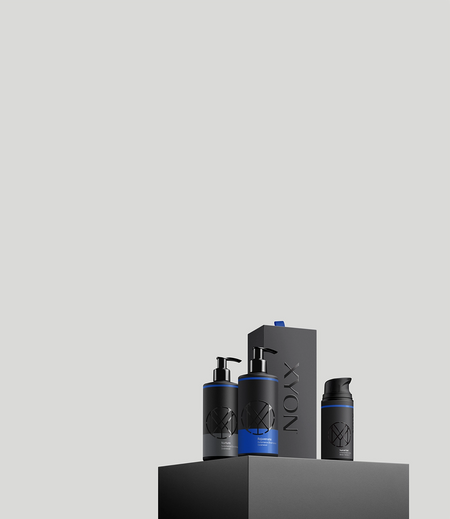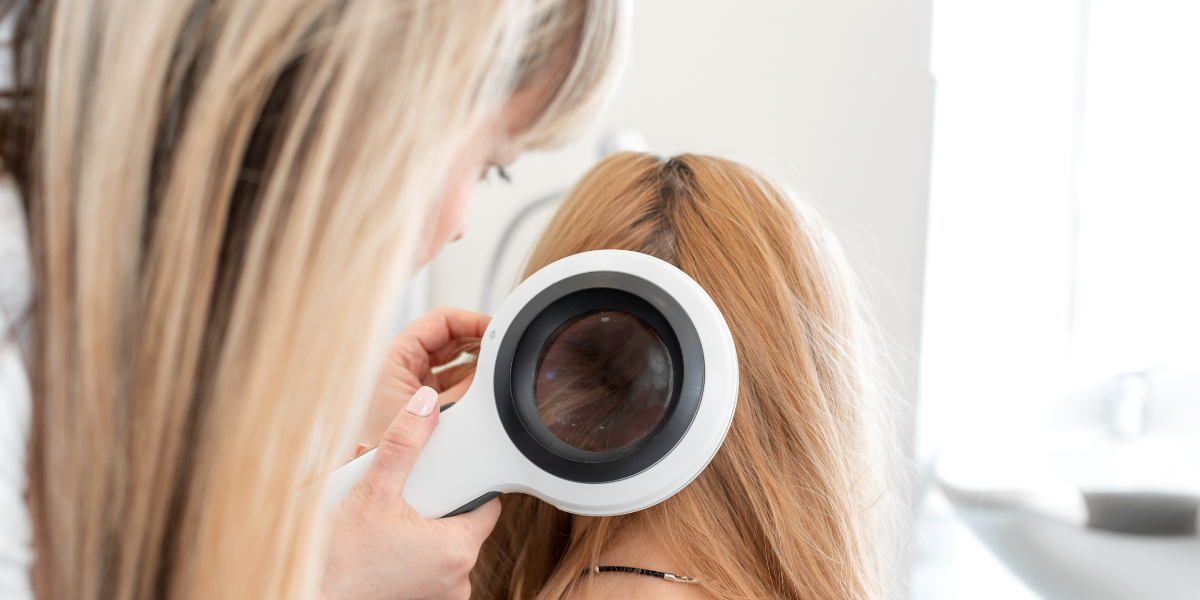In this article, we break down everything you need to know about dutasteride vs finasteride. Read on for more information on dutasteride vs finasteride cost, dutasteride vs finasteride side effects, dutasteride vs finasteride results and what you need to know about these hair loss treatments.
How do these medications work and how are they different?
Dutasteride and finasteride are used to effectively treat male pattern hair loss (also known as androgenetic alopecia). Both medications belong to a class of drugs which aim to lower dihydrotestosterone (DHT) levels by blocking an enzyme called 5-alpha reductase (5-AR). This is the enzyme responsible for converting testosterone into DHT.
As you may know, elevated DHT levels at the scalp is one of the primary causes of male pattern hair loss. Both finasteride and dutasteride prevent the chemical conversion of testosterone into DHT from occurring, reducing the concentration of DHT within the body over time. As this happens, the concentration of DHT at the scalp will decrease, which can slow hair loss and even promote hair growth in many cases.
So, if both drugs block the 5-AR enzyme, how are they different?
Well, there are three different versions of the 5-AR enzyme, which all contribute to DHT production to some degree. Finasteride only has the ability to target one structural variant, known as 5-AR type 2. Whereas dutasteride can actually act on two different variants: 5-AR type 1 and 5-AR type 2.


Get the right solution for your hair loss.
XYON is proud to offer finasteride and dutasteride. Connect with an expert today to find out which one is right for you.
Is dutasteride better than finasteride?
Ultimately, there’s no right or wrong answer to this question since hair loss is multifactorial and it can vary from person to person. This means that the way your body responds to hair loss medication may be different, compared to someone else.
But you’re probably thinking that since dutasteride targets more than one subtype of the 5-AR enzyme, it must be better right?
Potentially. But there are many other factors to take into account, including the effects on DHT levels throughout the rest of the body.
The 5-AR type 2, which both finasteride and dutasteride can target, contributes more to the overall production of DHT than any other variants of the 5-AR enzyme. It’s primarily active within the hair follicles throughout the body (Hirshburg et al, 2016). It’s worth noting that some research has proven dutasteride to be up to 3x more effective at lowering 5-AR type 2 activity, compared to finasteride (Clark et al, 2004).
When you consider this, on top of the fact that dutasteride can target an additional form of 5-AR enzyme, it’s reasonable to presume that it would be the more effective treatment for pattern hair loss. In fact, further research has shown that dutasteride can reduce DHT levels at the scalp by around 90% (Rittmaster et al, 2008). Though, finasteride is not far behind – it's thought to reduce scalp DHT levels by 70% for most men (Mysore, 2012).
All things considered, dutasteride may be a better option for those suffering from more severe hair loss.

Can you take finasteride & dutasteride together?
Taking a combination approach to treating hair loss is common and increasingly supported, but this is generally dutasteride or finasteride combined with minoxidil. This can be particularly effective because minoxidil has a different way of working to promote hair growth. So, using these medications in adjunct can help to target more than one cause of hair loss.
But what about using finasteride and dutasteride together – is it safe? And if so, is it any more effective than using them alone?
Well, the research looking at combining these two medications is fairly limited. However, during one small clinical study, a man with pattern balding who had been taking finasteride for 4 years, decided to add a low dose of dutasteride to his regimen. He found that adding the dutasteride significantly increased his hair growth and density (Boyapati & Sinclair, 2013).
However, the research doesn’t go much further than this and so, there likely isn’t enough evidence to support the safety and efficacy of using these medications together. Instead, switching from finasteride to dutasteride, or vice versa, may be a better solution if you’re not achieving the results you had hoped for from your current treatment. It’s important to speak to your prescribing physician before making any changes to your medication.
What to expect when switching from finasteride to dutasteride
If you have decided to switch from finasteride to dutasteride and your prescribing physician has agreed that you’re a suitable candidate for this, it’s important to understand what might happen during this transition.
When making this switch, you might notice some hair shedding and this will be similar to the initial shedding that some patients experience when they first start taking finasteride or dutasteride. This is a normal reaction and it’s just your body adjusting to the new changes to your hair growth cycle. It shouldn’t last longer than 3 months and you should speak to your doctor if you’re concerned.
It’s important to stick with your treatment to achieve the long-term benefits of dutasteride. Unfortunately, hair regrowth doesn’t happen overnight but being consistent with your treatment will give your hair the best chance. It may help to hear that research reassures us it’s worth sticking with dutasteride in the long-run, with a study finding dutasteride to be superior to finasteride at improving total hair count after 24-weeks (Shanshanwal & Dhurat, 2017).
What are the side effects of dutasteride compared to finasteride?
It’s difficult to compare the side effects of dutasteride and finasteride since they seem to be very similar. However, some research has suggested that the risk of side effects might be slightly higher with dutasteride due to its dual action on the 5-AR enzyme. The additional 5-AR isoform which dutasteride can target may increase the impact on the levels of circulating DHT throughout the body. It’s these systemic changes which cause side effects, including:
- Erectile dysfunction
- Decreased sex drive
- Reduced sperm count
- Testicular pain or tenderness
- Breast enlargement or tenderness
Whilst finasteride can also cause these side effects, the risk with dutasteride may be slightly higher.
Why does dutasteride cause erectile dysfunction?
While sexual-related side effects may be a risk of dutasteride, it's important to remember that preliminary research on dutasteride shows that it’s safe and generally well tolerated by patients (Marihart, 2005). But why can dutasteride cause these side effects in some men?
Whilst the aim of dutasteride for hair loss treatment is to block DHT production at the scalp, it can also cause lowering of DHT throughout the body. This means that it can interfere with normal hormone levels throughout the body, potentially causing side effects in men who are sensitive to these changes.
Opting for a topical dutasteride may lower the risks of experiencing systemic side effects, since it can help to limit the amount of active ingredients entering the bloodstream.

What is the ideal dose of dutasteride?
Since dutasteride isn’t yet FDA or Health-Canada approved for the treatment of hair loss, the ‘ideal dose’ isn’t quite as set-in-stone as other medications. But it’s most commonly prescribed off-label for hair loss at an oral dose of 0.5mg per day. Patients may receive a lower prescription of 0.125 or 0.25mg per day, depending on individual factors, such as risk tolerance to side effects.
It becomes a little bit more complicated when discussing topical dutasteride dosages and this is because the formula of your chosen topical solution will alter how much active medication is absorbed into the bloodstream. For example, XYON’s SiloxysSystem Gel™ was specifically designed to deliver medication to areas of the scalp where it’s needed, whilst limiting the amount of active ingredient that enters the bloodstream. This was done with the intention of reducing the risk of experiencing side effects associated with hair loss medications.
Based on independent clinical studies, XYON’s topical dutasteride contains a 2% concentration of medication and this was ultimately landed on because it strikes the right balance between safety and efficacy.
Is dutasteride more expensive than finasteride?
When comparing the cost of dutasteride vs finasteride, there are a few things to consider. Finasteride is more commonly prescribed as a treatment for hair loss than dutasteride. This generally means that you can get it at a lower cost. Oral finasteride is approved by the FDA (Food and Drug Administration) to treat male pattern hair loss. The generic form of this medication can be a more affordable treatment for hair loss.
Topical finasteride is a compounded medicine, which means it must be prepared on an individual basis. Compounded medicines can only be prepared and dispensed by select compounding pharmacies, which can increase the cost of the medicine. Different topical finasteride formulations can also vary in cost.
Some variables that contribute to the cost of topical formulations include:
- the efficacy of the vehicle
- its ability to minimize adverse effects
- how it may feel on the skin
These factors can have an impact on a patient's decision to stick with and follow a treatment, which ultimately can affect their results.
Dutasteride can be a more costly hair loss treatment than finasteride, as the drug often comes at a higher price point. Some patients still opt for dutasteride despite this because it can be more effective than finasteride in treating male pattern baldness. Its demonstrated clinical efficacy may make it a better choice for some patients.
Ultimately, the finasteride vs dutasteride cost debate comes down to individual needs and preferences. Those who are looking for a more affordable option may opt for oral finasteride, while those seeking a more effective treatment regardless of cost may choose compounded topical dutasteride.
In some regions, certain hair loss treatments are covered by health insurance, which can help cover the cost of dutasteride and finasteride. No matter which drug you choose, it's important to make an informed decision when considering finasteride vs dutasteride cost. Ultimately, the best choice is up to each patient and their doctor

Finasteride vs dutasteride: Takeaway
So, what’s the verdict when it comes to comparing dutasteride vs finasteride? Dutasteride is typically the more expensive option. The risk of side effects with dutasteride vs finasteride may be greater as well. However, this medication continues to be an option for many men with hair loss because it has shown to be an effective treatment.
Oral finasteride is still a top recommendation to treat hair loss because it is an FDA-approved hair loss treatment. But topical finasteride can also be considered as a compounded prescription medication to help reduce the risk of side effects that some men experience with oral finasteride.
Dutasteride and finasteride are commonly used to treat male pattern hair loss. These prescription medications work similarly, but may differ with regards to cost, results and side effects. You should always consult with a licensed physician to help you decide which hair loss treatment is ultimately right for you.
References:
Boyapti, A., Sinclair, R. (2013). Combination therapy with finasteride and low-dose dutasteride in the treatment of androgenetic alopecia. The Australasian Journal of Dermatology, 54(1). 10.1111/j.1440-0960.2012.00909.x
Clark, R.V., Hermann, D.J., Cunningham, G.R., Wilson, T.H., Morrill, B.B., Hobbs, S. (2004). Marked suppression of dihydrotestosterone in men with benign prostatic hyperplasia by dutasteride, a dual 5a-reductase inhibitor. The Journal of Clinical Endocrinology & Metabolism, 89(5). https://doi.org/10.1210/jc.2003-030330.
Hirshburg, J.M., Kelsey, P.A., Therrien, C.A., Gavino, A.C., Reichenberg, J.S. (2016). Adverse effects and safety of 5-alpha reductase inhibitors (finasteride, dutasteride): A systemic review. Journal of Clinical and Aesthetic Dermatology, 9(7).27672412.
Marihart, S., Harik, M., Djavan, B. (2005). Dutasteride: A review of current data on a novel dual inhibitor of 5a reductase. Reviews in Urology, 7(4).16985831
Mysore, V. (2012). Finasteride and sexual side effects. Indian Dermatology Online Journal, 3(1).23130269.
Rittmaster, R., Hahn, R.G., Ray, P., Shannon, J.B., Wurzel, R. (2008). Effect of dutasteride on intraprostatic androgen levels in men with benign prostatic hyperplasia or prostate cancer. Urology, 72(4). 10.1016/j.urology.2008.06.032.
Shanshanwal, S.S., Dhurat, R.S. (2017). Superiority of dutasteride over finasteride in hair regrowth and reversal of miniaturization in men with androgenetic alopecia: A randomized controlled open-label, evaluator-blinded study. Indian Journal of Dermatology, Venereology and Leprology, 83(1). 10.4103/0378-6323.188652.




